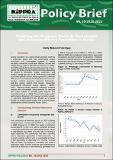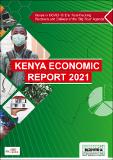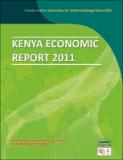Kenya Economic Report 2022 on Building Resilience and Sustainable Economic Development in Kenya
Publication Date
2022Author
Type
KIPPRA Publicationsviews
downloads
Metadata
Show full item recordBy
The Kenya Institute for Public Policy Research and Analysis (KIPPRA)
Abstract/
Kenya’s economy rebounded strongly in 2021 amid the COVID-19 pandemic disruptions, high global fuel prices and low precipitation experienced in the country during the year. The economy grew by 7.5 per cent in 2021 compared to a contraction of 0.3 per cent in 2020. The rebound followed the reopening of the economy, roll out of COVID-19 vaccination and reversal of COVD-19 tax measures that boosted revenues to support spending. Strong recoveries were recorded in services and industry while agriculture recorded a contraction. Agriculture, forestry, and fishing activities shrunk by 0.2 per cent due to dry weather conditions while all services activities recorded strong growth. The services activities that showed strong performance include accommodation and food services (52.5%), education (21.4%), arts, entertainment, and recreation (13.7%), financial and insurance (12.5%), information and communication (8.8%), wholesale and retail trade (7.9%) and transport and storage (7.2%). Industrial activities also recorded growth, with mining and quarrying growing by 18.1 per cent, manufacturing by 6.9 per cent, electricity supply by 4.4 per cent, water supply, sewerage, and waste management by 6.4 per cent, and construction by 6.6 per cent. The macroeconomic environment witnessed increased consumer prices in 2021; however, overall inflation remained within the Government’s target band. The Central Bank of Kenya continued implementing monetary accommodation to support growth while lending rates were higher in 2021 compared to 2020. The continued depreciation of the exchange rate to dollar given the global market developments put pressure on prices and cost of external public debt. Noteworthy, revenues rebounded strongly in the first half of 2021/22, with virtually all tax heads recording above target collections. Total revenue inclusive of grants exceeded the target by Ksh 28.6 billion while improved growth was posted in Pay as You Earn (PAYE), Value Added Tax (VAT) imports, excise duty, appropriations-inaid, and corporate income taxes. These resulted into narrowing of fiscal deficit in the first half of the year.
Subject/
Sustainable Development; Macroeconomic Performance; Economic Prospects; Sustainable Livelihoods; Socio-Economic Resilience
Publisher
The Kenya Institute for Public Policy Research and Analysis (KIPPRA)Series
KER;2022Collections
Related items
Showing items related by title, author, creator and subject.
-
Policy Brief No. 05 of 2022-2023 on Tracking the Progress Towards Sustainable and Inclusive Energy Transition in Kenya
Mbaka, Charity & Ngugi Rose (The Kenya Institute for Public Policy Research and Analysis, 2022)Energy transition is a policy-driven process involving a systematic global shift from fossil-based energy production and consumption systems to carbon neutrality, renewable, sustainable, efficient, secure, and ... -
Kenya Economic Report 2021 on Kenya in the Covid-19 Era: Fast-Tracking Recovery and Delivery of the "Big Four" Agenda
The Kenya Institute for Public Policy Research and Analysis (KIPPRA) (The Kenya Institute for Public Policy Research and Analysis (KIPPRA), 2021)The Kenya Economic Report (KER) 2021 is the thirteenth in a series of annual reports prepared by the Kenya Institute for Public Policy Research and Analysis (KIPPRA), pursuant to the KIPPRA Act No. 15 of 2006. The ... -
Kenya Economic Report 2011 on Transformative Institutions for Delivering Kenya Vision 2030
Kenya Institute for Public Policy Research and Analysis (KIPPRA) (The Kenya Institute for Public Policy Research and Analysis (KIPPRA), 2011)The Kenya Economic Report (KER) 2011 is the third in a series of annual reports on the Kenyan economy prepared by the Kenya Institute for Public Policy Research and Analysis (KIPPRA) pursuant to the KIPPRA Act No. 15 of ...




